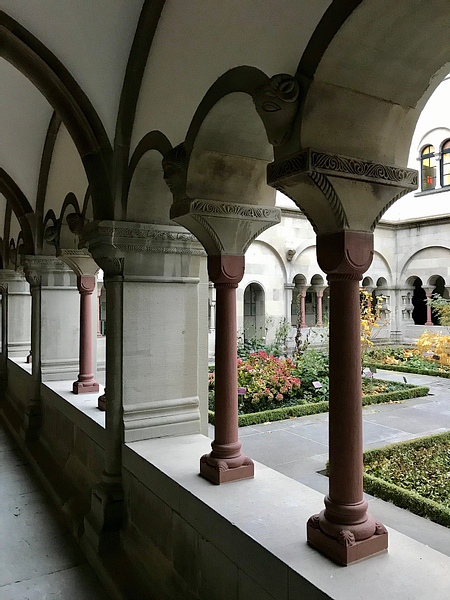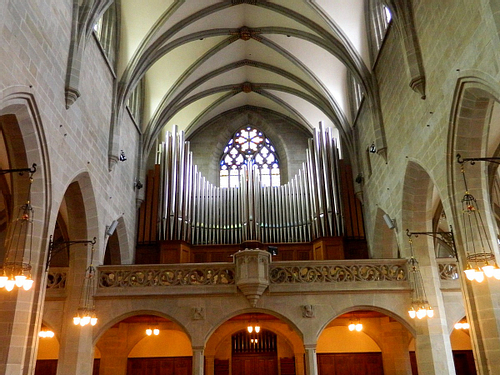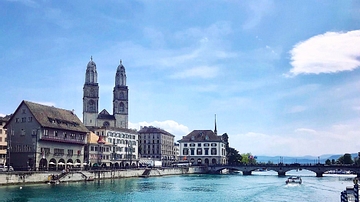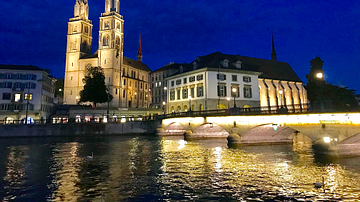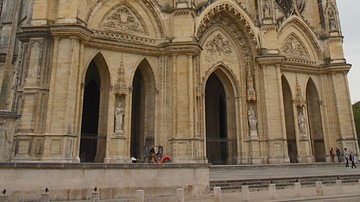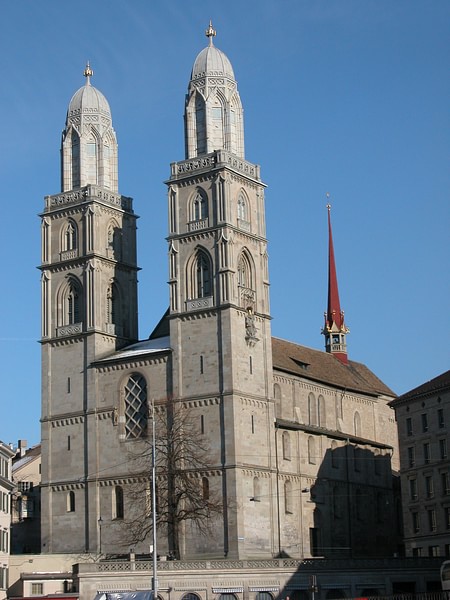
Grossmünster (“large cathedral” in German) is a Romanesque ex-cathedral situated in the heart of Zürich, Switzerland, which was built over the course of the 11th and 13th centuries CE. According to legend, the Holy Roman Emperor Charlemagne founded Grossmünster around c. 810 CE to house the bones and relics of the early Christian martyrs St. Felix, St. Regula, and St. Exuperantius who were believed to have fled to Zürich and died in city during the 3rd century CE. Grossmünster is Zürich's most recognizable and famous landmark by virtue of its iconic twin towers, and it retains a place of prominence in Protestant Christianity due to its role in the Protestant Swiss Reformation, which began at the direction of Ulrich Zwingli in 1519-1520 CE. Along with Fraumunster, Predigerkirche, and St. Peterskirche, Grossmünster is one of the oldest and largest churches in Zürich. Its triple-aisled crypt is also the largest in Switzerland.
Legends & Medieval History
Legend has it that the patron saints of Zürich - Felix, Regula, and their servant Exuperantius - were once members of the Christian Thebaic Legion, which had its base in what is now the Swiss canton of Valais. Due to the intense persecution of Christians by Roman authorities in the region, Felix, Regula, and Exuperantius fled to Zürich at some point in the late 3rd century CE. When Roman authorities in Zürich discovered their Christian beliefs, the Roman governor of Turicum - Roman Zürich - forced the three Christians to be boiled in oil and drink molten lead. Soon thereafter, he ordered the three Christians beheaded. Folklore has it that after their executions, Felix, Regula, and Exuperantius calmly picked up their severed heads and walked 40 paces - or about 27 m (30 yards) - to the place where they wished to find eternal rest and ascend to heaven. About 500 years later, Charlemagne (r. 800-814 CE) came to Zürich in pursuit of a large stag that he had seen while out hunting around Aachen, Germany. Upon arrival in Zürich, Charlemagne's horse stumbled over the graves of the three saints, and it was there that Charlemagne ordered the construction of a new church along the Limmat River: the Grossmünster Cathedral.
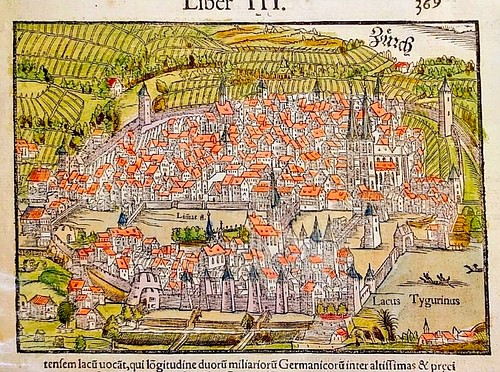
The basilica of Grossmünster was constructed in six stages from c. 1090-1230 CE and was erected over a 9th-century CE Carolingian building of similar dimensions. Architects made periodic renovations and structural alterations to Grossmünster in later centuries; most notably, increasing the cathedral's southern tower to match the height of the northern tower in the late 15th century CE. Grossmünster's organization and activities were overseen by the bishopric of Konstanz, Germany until the advent of the Reformation in the 16th century CE, and Grossmünster was both part of a secular canon's monastery and a parish church until that time too.
During the Middle Ages, Grossmünster's fortunes were intricately connected to those of Fraumünster, which was the nearby Benedictine convent located only 180 m (551 ft) across the Limmat River. These two churches stood facing from one another, dominating Zürich's skyline as the two largest structures in the city and as pillars of the influence and power of the Catholic Church in northern Switzerland. The two churches were, however, in perpetual rivalry with one another for control over the relics of St. Felix, St. Regula, and St. Exuperantius. The two churches shared and publically showcased these relics in an elaborate urban procession held annually on September 11th. (That day is the feast day of the three saints; this day is still celebrated as a holiday in the city of Zürich.) Zürich emerged as an important pilgrimage center by the late Middle Ages as the faithful visited the relics of the three saints while en route to other pilgrimage centers like Santiago de Compostela in Spain, the Vatican in Rome, Italy, and the Benedictine Abbey in Einsiedeln, Switzerland, which lies only 40 km (25 miles) to Zürich's southeast.
Protestant Reformation & Austere Modernity
In 1519 CE, Ulrich Zwingli (1484-1531 CE) arrived in Zürich to begin his new work as pastor at Grossmünster Cathedral. Though born into a family of farmers, Zwingli was an educated man who completed his studies at the University of Vienna and University of Basel. The ideas of the Dutch philosopher Erasmus (1466-1536 CE) strongly influenced Zwingli, who shared Erasmus' belief that scripture should be read and preached liberally in one's native language as opposed to Latin. Zwingli quickly broke with established Catholic tradition soon after his arrival in Zürich, preaching a new, radical interpretation of the Gospels. Decidedly against a literal interpretation of the Eucharist, the selling of indulgences, the veneration of saints and relics, and the celibacy of priests, Zwingli additionally denounced the Catholic mass, Swiss men who worked as mercenaries in foreign armies, and perceived forms of idolatry in Catholic worship. Reforming the church in Zürich, Zwingli argued, was necessary so that Zürchers could live a life according to the Gospels as Jesus Christ had truly intended. Zwingli, with governmental approval and cooperation, dissolved Zürich's monasteries, confiscated the possessions belonging to Zürich's various churches and monasteries, and desecrated the graves of holy martyrs. (However, what exactly happened to the relics of Saints Felix, Regula, and Exuperantius remain a topic of debate between Protestants and Catholics in Switzerland.)
Grossmünster, like the other churches, abbeys, and monasteries in the Canton of Zürich, was profoundly affected by Zwingli's reforming zeal. The current austere simplicity of Grossmünster's interiors is a direct result of Zwingli's Reformation. In 1524 CE, reformers removed Grossmünster's organ and religious statuary. Decorated walls were whitewashed, and Grossmünster's stained glass windows were removed. It is worth noting that Zwingli, himself, never endorsed an iconoclastic removal of religious images, and he never sanctioned violence that would run counter to the interests of Zürich secular authorities. That being said, acts of iconoclasm occurred throughout the summer of 1524 CE in Zürich, which would in turn be mirrored by the actions of Protestant communities in Germany, England, Scotland, the Netherlands, France, Denmark, and Belgium.
Following Zwingli's death in 1531 CE, Heinrich Bullinger (1504-1575 CE) became the chief pastor at Grossmünster Cathedral. His tenure was one of relative peace and calm compared to that of his predecessor. While just as fiery in his sermons as Zwingli had been, Bullinger was of a prudent, diplomatic, and charitable character. He continued Zwingli's work in overseeing Grossmünster's theological school and corresponded with leading figures of his era, including Martin Luther, Jean Calvin, and Elizabeth I (r. 1558-1603 CE). Under Bullinger's aegis, Grossmünster retained its position of prominence among Zürich's churches, and Bullinger helped Grossmünster avoid the organizational and legal troubles that commonly faced other large cathedrals during the Reformation and Counter-Reformation. The latter history of Grossmünster is largely quiet. Aside from a fire in 1763 CE that destroyed Grossmünster's towers - they were rebuilt in a gothic “box” style a few years later - the past four centuries have been mostly uneventful. A period of refurbishment commenced in the late 19th and early 20th centuries CE, which saw Grossmünster's Romanesque appearance restored to its full splendor. A pulpit was restored in 1851 CE and an organ returned in 1960 CE. Stained-glass windows by the famed Swiss artist Augusto Giacometti (1901-1966 CE) were installed in 1933 CE as well.
Architectural & Archaeological Notes
Grossmünster Cathedral largely adheres to the basic tenets of Romanesque style: grotesques on column capitals, carved portals, and church towers. Grossmünster's cloisters have elegant groin vaulting, and its nave has a pointed vaulting. The cathedral at Constanz, Germany, as well as other Norman and Lombard Romanesque churches strongly influenced the outline of Grossmünster's physical shape and façades. Recent archaeological surveys have shown that prior to the construction of a Carolingian edifice, there were ancient Roman structures as well as a Roman burial ground where Grossmünster now stands.
Grossmünster is unique in that one enters the cathedral from its north side rather than the more traditional west portal. This is because Grossmünster's southern and northern entrances formed part of a pilgrimage axis that linked the cathedral to the nearby, small Water Church (German: Wasserkirche) - built on the site where St. Felix, St. Regula, and St. Exuperantius were executed - and Fraumünster. On its north side, Grossmünster has a portal in the form of a classical Roman arch, denoting the triumph of the Christian faith. On the main portal, one can observe the Romanesque figure of King David of Israel playing a harp in addition to two lions. Surviving Gothic wall paintings depicting the legend of Felix and Regula and a 15th-century CE statue of Charlemagne in Gothic style are located in a 12th-century CE triple-aisled crypt beneath Grossmünster. A column capital in the church's north aisle contains a fine image of Charlemagne riding a horse as well. Directly beside Grossmünster Cathedral is the chapterhouse and the cloister, which dates from c. 1170 CE.
